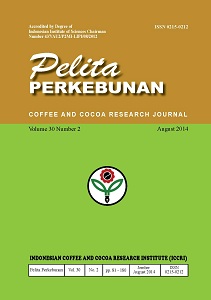Early Yield and Economical Study of Pogostemon Cablinas Intercrop in Young Cocoa (Theobroma cacaoL.)

Article Sidebar

PDF

Published
Aug 31, 2006
DIMENSION
ALTMETRIC
Main Article Content
Adi Prawoto
Indonesian Coffee and Cocoa Research Institute
M Sholeh N.P
Indonesian Coffee and Cocoa Research Institute
Abstract
Pogostemon cablinis an important source of volatile oil for pharmaceutical and cosmetical products. Agronomical aspect of this commodity needs open ecosystem, but for certain level of shading, this crop may yield economically. A study to evaluate the effect of P. cablinintercropped on young cocoa farm, had been conducted during 2005, in Kaliwining Experimental Station of Indonesian Coffee and Cocoa Research Institute (ICCRI) 45 m above sea level, D climate type (Schmidt and Fergusson), and on low gley humic soil. The experiment was arranged in factorial and the field design was split plot replicated three times. The main plot was no shade tree, shade of Leucaena glauca and Areca catechuwhile the subsplots were fertilizer dose (per ha/year), i.e. (P0) without fertilizer; (P1) 140 kg Urea, 35 kg SP-36, 70 kg KCl; (P2) 280 kg Urea, 70 kg SP-36,140 kg KCl; and (P3) 560 kg Urea, 140 kg SP-36, 280 kg KCl. The result showed that P. cablin cultivation without shading gave better growth and yield than the shading treatment; meanwhile Leucaenashading showed better growth and early yield than the A. catechushading. Fertilizer rate of P1 produced highest leaf weight and oil yield, although P3 possessed the highest growth variables of plant height, stem diameter, number of leaves, leaf area and chlorophyll content. For the dry weight biomass variable, highest yield was obtained from no shade tree and P1 treatment. Using chromatography gas analysis, retention time of patchouly alcohol is 15—18 minutes, it was found that the content was influenced by shading treatment, i.e. 25.15% in monoculture, 28.73% in Leucaena and 25.21% in A. catechutreatment. For the oil viscosity variable, the monoculture treatment showed the highest value (23.21 centipoise), followed by A. catechu(11.60 centipoise) and Leucaenatreatment (8.65 centipoise). Intercropping of P. cablinwith young cacao did not show negative effect on young cacao growth. This study demonstrated that pre-cropping ofP. cablinin young cacao provided opportunity to farmers to have additional income, the benefit cost ratio (B/C) for Leucaenatreatment 1.00–1.35 depend on dose of fertilizer, while for A. catechutreatment gave no profit (B/C 0.59–1.03 depend on fertilizer dose). Meanwhile, P. cablinmonoculture cultivation gave B/C 1.44–2.71. Key Words: Pogostemon cablin, Theobroma cacao,Leucaena glauca, Areca catechu, intercropping, patchouly alcohol, B/C ratio, fertilizer.
Article Details
How to Cite
Prawoto, A., & Sholeh N.P, M. (2006). Early Yield and Economical Study of Pogostemon Cablinas Intercrop in Young Cocoa (Theobroma cacaoL.). Pelita Perkebunan (a Coffee and Cocoa Research Journal), 22(3). https://doi.org/10.22302/iccri.jur.pelitaperkebunan.v22i3.48
Issue
Section
Articles

This work is licensed under a Creative Commons Attribution-NonCommercial 4.0 International License.
Authors who publish with this journal agree to the following terms:
- Authors retain copyright and grant the journal right of first publication with the work simultaneously licensed under a Creative Commons Attribution License that allows others to share the work with an acknowledgement of the work's authorship and initial publication in this journal.
- Authors are able to enter into separate, additional contractual arrangements for the non-exclusive distribution of the journal's published version of the work (e.g., post it to an institutional repository or publish it in a book), with an acknowledgement of its initial publication in this journal.
- Authors are permitted and encouraged to post their work online (e.g., in institutional repositories or on their website) prior to and during the submission process, as it can lead to productive exchanges, as well as earlier and greater citation of published work (See The Effect of Open Access).
Most read articles by the same author(s)
- Adi Prawoto, Pattern of Flushing, Cherelle Wilt, and Accuracy of Yield Forecasting of Some Cocoa Clones , Pelita Perkebunan (a Coffee and Cocoa Research Journal): Vol 30 No 2 (2014)
- Adi Prawoto, A Study of Allelopathy of Some Shade Trees to Coffea arabicaL. Seedlings , Pelita Perkebunan (a Coffee and Cocoa Research Journal): Vol 22 No 1 (2006)
- Oscar Regazzoni, Yogi Sugito, Agus Suryanto, Adi Prawoto, Physiological Character of Cocoa Clones that Cultivated under Three Species of Shade Trees , Pelita Perkebunan (a Coffee and Cocoa Research Journal): Vol 30 No 3 (2014)
- Oscar Regazzoni, Yogi Sugito, Agus Suryanto, adi prawoto, Solar Energy Efficiency of Cocoa Clones which Cultivated under Three Species of Shade Trees , Pelita Perkebunan (a Coffee and Cocoa Research Journal): Vol 31 No 1 (2015)
- Adi Prawoto, Coffee Yield and Mineral Cycle in Intercropping of Coffea canephora and Some Species of Timber Shade Trees , Pelita Perkebunan (a Coffee and Cocoa Research Journal): Vol 24 No 1 (2008)
- Rudy Erwiyo, Adi Prawoto, Soil Nutrient Condition of Coffee Cultivation with Industrial Woody-crops , Pelita Perkebunan (a Coffee and Cocoa Research Journal): Vol 24 No 1 (2008)
- Ketut Anom Wijaya, Adi Prawoto, Syrril Ihromi, Induction of Cocoa Natural Resistancy to Cocoa Pod Borer by Silica Application , Pelita Perkebunan (a Coffee and Cocoa Research Journal): Vol 25 No 3 (2009)
- Adi Prawoto, Nurul Qomariyah, Sri Rahayu, Bambang Kusmanadhi, (Agronomical and anatomical study of resulted early cocoa (Theobroma cacao L.) grafting , Pelita Perkebunan (a Coffee and Cocoa Research Journal): Vol 21 No 1 (2005)
- Fitria Yuliasmara, Aris Wibawa, Adi Prawoto, Carbon stock in different ages and plantation systemof cocoa: allometric approach , Pelita Perkebunan (a Coffee and Cocoa Research Journal): Vol 25 No 2 (2009)
- Fitria Yuliasmara, Aris Wibawa, Adi Prawoto, Carbon stock in different ages and plantation system of cocoa: allometric approach , Pelita Perkebunan (a Coffee and Cocoa Research Journal): Vol 26 No 3 (2010)
